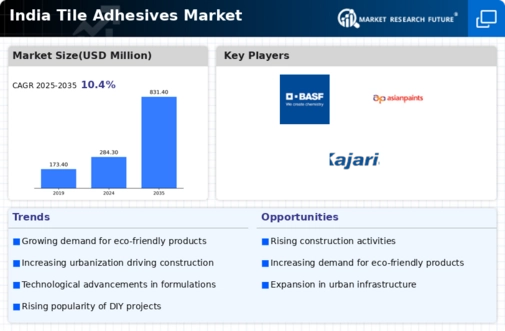Indian tile adhesives market is characterized by the presence of a competitive landscape comprising of major companies whereby the Indian MYK LATICRETE India Inc. has stood out as the top participant in the sector. Being the joint venture of the MYK Group and the LATICRETE International, which is based in the USA, the company drives the market with its intensive technical specialization at tile and stone installation systems, full product families range and close collaboration with contractors.
Pidilite Industries Ltd. is another major player that runs its successful brands and chain of stores and Asian Paints, which has built on its position in decorative paint to tile adhesives with SmartCare brand. Multinational corporations like Sika AG, BASF, Ardex Group, and Saint-Gobain introduce high-level R&D and a system-based approach to this market segment. Competitive environment is also changing towards value added offerings, specification-based selling, and training based differentiation particularly in high growth products like wet area work and large format tile.
The key players in this market are MYK LATICRETE India Inc., Pidilite Industries Ltd., ReynoArch Construction Chemical, Arkema, BASF, Asian Paints, Sika AG, Ardex Group, Kajaria Ceramics Limited, Saint-Gobain Group.
MYK LATICRETE, established in 2000 as a joint venture between India's MYK Group and US-based LATICRETE International, has focused exclusively on tile and stone installation systems with headquarters in Hyderabad, India. With manufacturing facilities in Hyderabad, Pune, and Kolkata and approximately 1,000 employees, the company combines American technical expertise with local market knowledge to serve the Indian subcontinent. MYK LATICRETE operates as a technical specialist with deep expertise specific to tile installation rather than general construction chemicals. The company offers a comprehensive range of products from basic adhesives to highly specialized solutions for the most demanding applications.
MYK LATICRETE emphasizes technical support, offering detailed specifications, on-site troubleshooting, and extensive contractor training programs. Their products are primarily targeted at the professional contractor segment rather than DIY users.
Asian Paints, founded in 1942 and headquartered in Mumbai, has grown from a small paint company to India's largest paint manufacturer and the third-largest in Asia, with operations spanning 15 countries. With approximately 6,500 employees and a revenue exceeding $3 billion, the company has successfully diversified from decorative paints into home improvement categories including waterproofing, wall putties, and adhesives. Asian Paints entered the tile adhesive market as part of its strategic expansion beyond decorative paints into the broader home improvement category.
The company leverages its powerful brand presence and extensive distribution network of 70,000+ dealers across India to market its SmartCare range of tile adhesives. The company has strategically positioned its tile adhesives to complement its waterproofing solutions, creating system solutions for bathrooms and wet areas while capitalizing on its strong relationships with builders and contractors to secure specifications for large residential and commercial projects and developing color-matched adhesives and grouts that coordinate with their paint palette to create cohesive design solutions.
Pidilite Industries, established in 1959 and headquartered in Mumbai, has evolved from an adhesive manufacturer to a dominant force in construction chemicals across India and emerging markets. With a portfolio spanning over 400 products and iconic brands like Fevicol, Dr. Fixit, and M-Seal, Pidilite commands exceptional brand loyalty among professionals and consumers alike. In the tile adhesives segment, Pidilite has strategically positioned its Dr. Fixit and Fevicol brands to capitalize on India's rapidly growing tile market.
The company's strategy centers on its extensive distribution network of over 100,000 retail touchpoints across India, combined with aggressive brand building that emphasizes quality and reliability. Pidilite focuses on offering a comprehensive range of tile adhesives for different applications, from basic to specialized solutions for challenging surfaces.














Leave a Comment